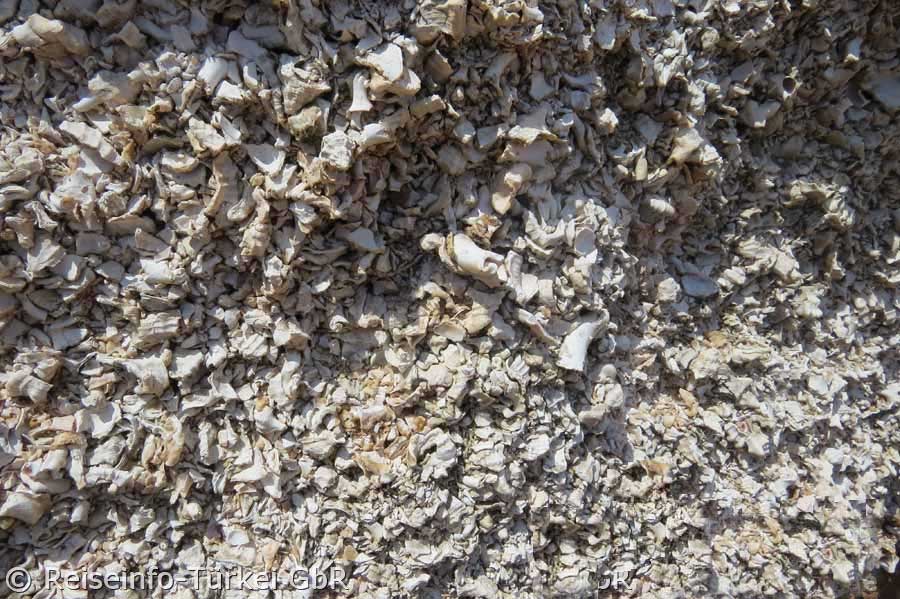|
Holiday on the Turquoise Coast |
|||
| Lycia |
|
||
| Andriake | |||
| The port of the ancient city of Myra | |||
|
|
|||
|
|
|||
| The port entrance today | |||
|
|
|||
|
Andriake was the port of ancient Myra, located five kilometers southwest of today's town of Demre in the Turkish province of Antalya, at the mouth of the river Andrakos (Kokar Çayı). Today, the port is silted up or marshy due to the river's alluvial deposits. |
|||
|
|
|||
| The Nymphaeum | |||
|
|
|||
|
Already during the construction of the
coastal road from Demre to Kaş in the 50s of the last century, the
former urban area had been cut through. Just above the access road
to the excavation area and to Çayağzı, as the "harbour" is called
today, the ruins of the nymphaeum have been preserved. One can only
guess what fell victim to the excavator during the construction of
the road and the later 4-lane extension to the D400. |
|||
|
|
|||
|
|
|||
| The modern entrance building to the ruins of Andriake | |||
|
For centuries
the ruins of Andriake went unnoticed, but rather served
residents of Kale, as Demre was formerly known, as a quarry for
the construction of their houses and stables.
Since 2005
in Andriake by a team of the Austrian Archaeological
Institutes field researches carried out. To expand the
Tourism in the region began under the supervision of Akdeniz Üniversitesi Antalya in December 2012 at
the granary
extensive restoration work, which will be completed in spring 2014
have been largely completed. |
|||
|
|
|||
| Today, paved paths lead from the visitor centre to the Agora and the granary | |||
|
|
|||
|
|
|||
| Renovated in 2013 and 2014, the granary is now a museum | |||
|
Archaeological evidence indicates that the site was founded in the early Hellenistic period. At that time the settlement extended over two hills on either side of the harbour entrance. The place is first mentioned in 197 BC, when Antiochos III conquered Andriake. In the course of the capture of the port by the Romans in 43 B.C., a chain that secured the port entrance was broken. The apostle Paul waited here in the autumn of 59 AD on his journey to Rome for better winds and changed ship (Acts 27:5-6). |
|||
|
|
|||
| The silted up harbour basin of Andriake | |||
|
Andriake was all
Apparently much larger than the today rather sparse remains of the
of the former development.
In the middle imperial period a
massive expansion of the port infrastructure. Besides the Granarium, a
(built in 129 AD), were built on the southern shore of the harbour basin
a large square and other buildings, today largely destroyed
erected. |
|||
|
|
|||
| The apse of a basilica | |||
|
|
|||
|
In the 6th century the harbour settlement experienced a further boom. Six large churches and two bathing facilities were built as well as numerous other buildings. The churches dated to the end of the 5th or the 6th century were three-nave basilicas, each with a semicircular apse on the east wall. |
|||
 |
|||
| Shells of purple snails | |||
|
The reason for this upswing is pretty sure to see the production of the dye purple. Natural purple was (and probably still is) one of the most expensive dyes in the world. The toga of the Roman emperors was dyed with purple, while Roman senators and magistrates wore a purple stripe on their togas. The dye
was/is derived from a gland of the snail Hexaplex trunculus
won. For one gram of paint, thousands of snails
be processed. So Andriake was one of the the most important production sites of antiquity, that over time the Andriacs have become overfished snails have robbed themselves of their livelihood. |
|||
|
|
|||
| Building at the Agora | |||
|
|
|||
|
|
|||
| The large cistern under the Agora is accessible today | |||
|
The town was probably abandoned in the early Middle Ages, probably due to the increasing siltation of the harbour basin. In Ottoman times, a small fort was built on the western tip of the northern settlement hill. |
|||
|
|
|||
| The granary from 129 AD before the restoration | |||
 |
|||
| The 65 x 32 meters large granary in autumn 2012 | |||
|
|
|||
| The restored granary in autumn 2016 | |||
|
|
|||
